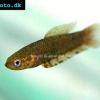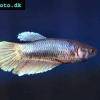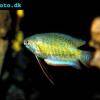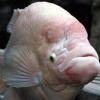Snakeskin gourami - Trichogaster pectoralis
Scientific name: Trichogaster pectoralis
Common name: Snakeskin gourami
Family: Osphronemidae
Usual size in fish tanks: 20 - 25 cm (7.87 - 9.84 inch)
014
Recommended pH range: 6 - 8.3
Recommended water hardness: 2 - 10°N (35.71 - 178.57ppm)
0°C 32°F30°C 86°F
Recommended temperature range: 23 - 28 °C (73.4 - 82.4°F)
The way how these fish reproduce: Spawning
Where the species comes from: South Asia
Temperament to its own species: peaceful
Temperament toward other fish species: peaceful
Usual place in the tank: Top levels
Snakeskin Gourami Overview
The Snakeskin Gourami (Trichogaster pectoralis) is one of the larger gourami species, known for its peaceful temperament and ease of care. Native to Southeast Asia, specifically in the slow-moving waters of Thailand and Cambodia, these fish can grow to a size of 20 to 25 cm (7.87 to 9.84 inches) in captivity. Their distinctive snakeskin-like pattern makes them a visually appealing addition to any large, well-maintained aquarium. Although they are peaceful toward other fish, their large size requires a spacious tank with plenty of plants and hiding spaces.
Tank Requirements
Given their size and need for space, Snakeskin Gouramis require a large aquarium of at least 200 liters (53 gallons). These fish thrive in well-planted tanks with areas of calm water, which mimic their natural habitat in Southeast Asia. Floating plants such as Water Lettuce and Salvinia can be used to provide shade and help reduce water flow, which these fish prefer. Additionally, plants like Java Fern, Anubias, and Cryptocoryne can offer hiding spots while enhancing the natural look of the aquarium.
Maintain water temperatures between 23-28°C (73.4-82.4°F) with a pH range of 6 to 8.3 and water hardness between 2 to 10°N (35.71 - 178.57 ppm). It's crucial to avoid sudden changes in water parameters, as Snakeskin Gouramis are sensitive to fluctuations. Ensure that the tank has a low to moderate current, as strong water flow can stress Snakeskin Gouramis. Regular water changes and a reliable filtration system are important to maintain optimal water quality and prevent the buildup of toxins.
Food and Feeding
Snakeskin Gouramis are not fussy eaters and will accept a variety of foods. Their staple diet should consist of high-quality flakes or pellets suitable for large fish. In addition to their main diet, treat them with live or frozen foods such as brine shrimp, bloodworms, and daphnia to mimic their natural feeding habits. A balanced diet is essential to maintain their vibrant coloration and overall health. Additionally, offering blanched vegetables like spinach or lettuce can provide variety. Be cautious of overfeeding, as excess food can lead to poor water quality. Feeding 2-3 times a day in small portions is recommended.
Sexing
Distinguishing between male and female Snakeskin Gouramis is relatively easy. Males typically have a more pointed and extended dorsal fin, while their pelvic fins display a reddish tint. Females, on the other hand, have shorter, more rounded fins and lack the red coloration.
Breeding
Snakeskin Gouramis are among the easiest gourami species to breed in captivity. The male constructs a bubble nest, often near floating plants or calm areas of the tank. Once the nest is built, the female will lay her eggs in the nest, and both parents will guard the eggs. A single spawning can produce up to 5000 fry, making this species highly prolific. However, raising the fry can be challenging due to their sheer number.
After hatching, the fry should initially be fed finely crushed flakes or infusoria. As they grow, they can be transitioned to newly hatched brine shrimp or other tiny live foods to support healthy growth. Ensure excellent water quality with frequent water changes, as poor water conditions can quickly become fatal for the fry. If necessary, consider separating the fry into multiple tanks to avoid overcrowding and ensure consistent growth rates.
Lifespan
With proper care, Trichogaster pectoralis can live for 3-5 years in captivity. Maintaining stable water conditions, a nutritious diet, and a low-stress environment is key to maximizing their lifespan. Ensuring compatibility with peaceful tank mates and reducing territorial disputes will also contribute to their longevity.
Compatibility and Tank Mates
Snakeskin Gouramis are peaceful and can be housed with other non-aggressive species in a community tank. Suitable tank mates include other peaceful fish such as Harlequin Rasboras, Neon Tetras, Corydoras Catfish, and small to medium-sized Plecos. However, it's important to note that Rasboras and Neon Tetras are most suitable as tank mates if they are introduced as juveniles, as larger Snakeskin Gouramis may view them as prey if introduced at a later stage when they are already fully grown.
Additionally, when selecting tank mates, consider species that can tolerate the same warmer water conditions (23-28°C) as Snakeskin Gouramis. Avoid housing them with aggressive or fin-nipping species, as this can lead to stress and potential injury. Given their large size, it is important to provide ample space to reduce territorial behavior, particularly during breeding.
Short Description
The Snakeskin Gourami (Trichogaster pectoralis) is a peaceful, large gourami species native to Southeast Asia. They require a spacious, well-planted tank with floating plants to mimic their natural habitat. These fish are easy to care for and breed, making them a popular choice for community tanks. They thrive in soft to slightly hard water, with a pH range of 6 to 8.3 and temperatures between 23 and 28°C (73.4 - 82.4°F). With proper care, they can live for up to 5 years.
Pictures
Thanks to Sayer for the picture! Other were bought from jjphoto.dk.





 Akar
Akar  Whiteseam
Whiteseam  Giant
Giant  Betta
Betta  Slender
Slender  Betta
Betta  Brown’s
Brown’s  Snakehead
Snakehead  Wine
Wine  Edith’s
Edith’s  Blue
Blue  Betta
Betta  Peaceful
Peaceful  Kapaus
Kapaus  Eyespot
Eyespot  Spotted
Spotted  Forest
Forest  Schaller’s
Schaller’s  Siamese
Siamese  Chukai
Chukai  Banded
Banded  Dwarf
Dwarf  Frail
Frail  Paradise
Paradise  Giant
Giant  Giant
Giant  Licorice
Licorice  Chocolate
Chocolate  Honey
Honey  Thick
Thick  Pearl
Pearl  Moonlight
Moonlight  Blue
Blue